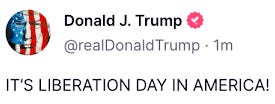Liberation Day or Economic Suicide?
On April 2, 2025, Donald Trump announced sweeping new tariffs, branding it “Liberation Day.” A universal 10% tariff was placed on all imports, alongside a 34% tariff specifically targeting China. “Many countries have ripped us off,” Trump declared. “Now it’s our turn to do the ripping.” But behind the patriotic slogans lies an economically incoherent strategy that triggered global backlash, market panic, and potential long-term damage to the U.S. economy.
Immediate Market Collapse
Just two days after the tariffs were introduced, on April 4, the U.S. stock market suffered its worst crash since the COVID-19 pandemic, erasing over $5 trillion in value within hours. Investors fled in fear of retaliatory trade action and rising inflation. Their fears were soon confirmed: China responded with an equal 34% tariff on U.S. goods, igniting a full-scale trade war. On April 9, Trump escalated again with a 50% tariff hike, prompting a mirror response from China. Instead of protecting American jobs, the policy ignited a global economic standoff.
Violation of Economic Fundamentals – Comparative Advantage
Trump’s tariff war contradicts the classical principle of comparative advantage, developed by David Ricardo. The theory posits that countries benefit by specializing in goods they can produce at lower opportunity cost and trading for the rest. Blanket tariffs distort this balance, forcing domestic production in inefficient sectors, raising costs for consumers, and misallocating resources. For example, making American firms produce goods that could be imported cheaply leads to less output, higher prices, and no real productivity gains.
Tariffs as Taxes – Deadweight Loss for Everyone
From a neoclassical economics standpoint, tariffs are essentially taxes on consumption. They raise domestic prices, reduce demand, and create inefficiencies. The result is deadweight loss — economic value that vanishes due to distorted incentives. Following Trump’s first round of tariffs in 2018–2019, studies showed nearly all the additional costs were passed on to U.S. consumers. This time, the damage is deeper and broader, with even staples like appliances and electronics becoming more expensive overnight.
Strategic Trade Theory? A Misguided Justification
Trump’s defenders argue that the tariffs align with strategic trade theory — the idea that governments can help domestic firms compete globally in high-tech sectors. But in practice, Trump’s approach is indiscriminate and punitive. Rather than focusing on sectors with spillover benefits or economies of scale, he applied blanket tariffs with no targeted investment in R&D (research and development) or innovation. This is not strategy; it’s economic nationalism masquerading as policy.
Fuel to the Fire – Inflation and Supply Chain Chaos
In a globalized economy, many U.S. firms rely on imported inputs. Tariffs increase their costs, which are then passed down the line to consumers. This results in cost-push inflation — prices rising not because of strong demand, but because production has become more expensive. The timing could not be worse. With the Federal Reserve already trying to curb inflation, Trump’s policy actively undermines macroeconomic stability and could push interest rates higher, hurting growth and employment.
The Return of Beggar-Thy-Neighbor Economics
Trump’s trade war strategy is a classic case of “beggar-thy-neighbor” policy — trying to improve domestic conditions at the expense of other countries. The world saw this in the 1930s with the Smoot-Hawley Tariff Act, which deepened the Great Depression and contributed to the tensions that led to World War II. Singapore’s Prime Minister Lawrence Wong warned, “The last time the world experienced something like this was in the 1930s… trade wars escalated into armed conflicts.”
Economic Comedy or Manipulation?
Trump even imposed a 10% tariff on imports from the uninhabited Heard and McDonald Islands near Antarctica. “The penguins were not happy,” social media joked. But the absurdity took a darker turn when Trump announced a 90-day pause on tariffs — except for China, whose tariff would jump to 125%. Trump then proclaimed, “This is a great time to buy!!!” prompting accusations of stock market manipulation, as the brief tariff reprieve temporarily lifted markets. Critics argue he engineered the swing to benefit insider interests, adding scandal to incompetence.
Ignoring Consumer Welfare and Inequality
Trump’s tariffs hit low- and middle-income Americans hardest. Trade liberalization, supported by theories like Heckscher-Ohlin and Stolper-Samuelson, shows that while there are winners and losers, consumers overall benefit from cheaper imports. Tariffs reverse this, functioning as regressive taxes. For instance, the New York Fed estimated that each steel job “saved” under Trump’s past tariffs cost over $900,000 per year in higher prices and economic disruption. In other words, the cost of “protection” far outweighs the benefits.
Populist Politics, Poor Economics
Trump’s tariffs are not a serious trade policy — they’re a political stunt. They violate well-established economic theory, provoke global retaliation, and hurt the very Americans they claim to protect. The global economy thrives on cooperation and specialization, not isolation and protectionism. If history is any guide, this new wave of tariffs won’t end in prosperity — but in economic damage, political instability, and deeper global divides. “Liberation Day” might one day be remembered not as a turning point, but as the beginning of another self-inflicted wound in America’s economic history.
For more information:
What tariffs has Trump announced and why?
Trading Day: Trump tariffs wipe $5 trillion off Wall Street
If this information was informative and educative, consider subscribing to the newsletter by pressing the subscribe button below:
Feel free to share this information with others by pressing the share button below:
Also engage in discussions by leaving comments below:
Your participation contributes to the collaborative and dynamic nature of the newsletter, creating a space for shared knowledge and diverse perspectives.







